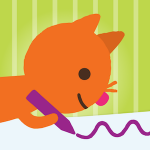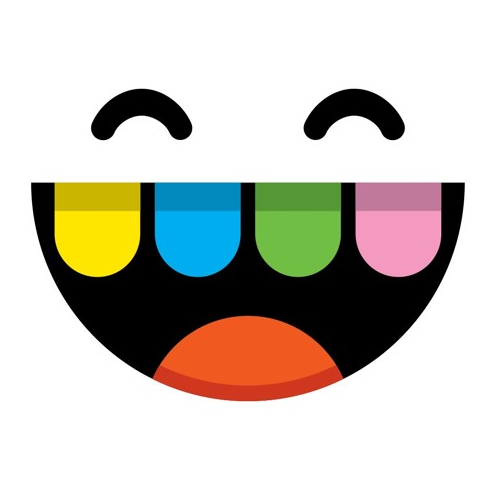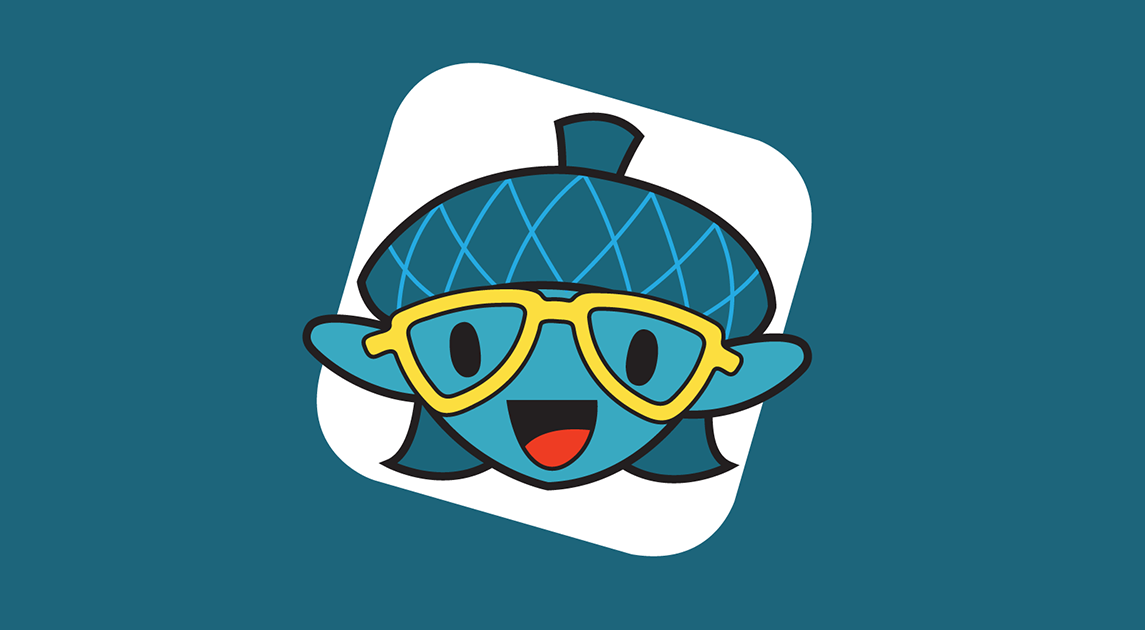This partial transcript of the App Fairy podcast has been edited for length and clarity. Please visit appfairy.org for more information about Sago Mini.
Carissa Christner: Hello and welcome to the App Fairy podcast. My name is Carissa Christner. I’m very excited to have an interview today with Sago Mini, one of my favorite app developers. They’re a company with exceptional apps for very young users—even kids as young as two and three years old. If a family is looking for recommendations of apps that are good to use with that age group, I always recommend Sago Mini first.
In October of 2015, I had the great fortune of visiting the offices of Sago Mini in Toronto, Ontario. While I was there, I got to speak to a bunch of different people who worked on the Sago Mini apps.
One of the people that I spent a lot of time talking with was an illustrator named Aaron. He’s the artist who creates all of the artwork for the Sago Mini apps. Thank you very much for taking the time to talk with us Aaron.
Aaron: You’re welcome. Great to be here.
CC: Tell us a little bit about how you started making apps.
AL: We’ve been creating interactive media for kids for quite a while—actually, since before the iPhone, if anyone can remember back that far! Seems like we’ve always had iPhones. Back then, the problem was that using a desktop computer was not actually intuitive or easy for young kids. Older kids could do it—they could make the connection between moving something on a desk and then seeing something move on a screen. But younger kids couldn’t. Preschoolers couldn’t really make that leap.
When the iPhone came along, it opened up opportunities to create touchscreen work for preschoolers, which almost no one was doing at that point. We were one of the first companies to do that. And then when the iPad came along a few years later, the larger screen opened things up even more. That’s some of the how and why we got started.
CC: You started off with a different name, right?
AL: Yes, the company was originally called Zinc Roe. Sago Mini apps were originally called Tickle Tap Apps. I designed the first characters back in 2009, I think. In 2013, we paired up with Toca Boca. They are our sister studio based in Sweden. And at that point we became Sago Mini.
CC: Do you have any stories about where or how you found inspiration for any particular app?

AL: Our apps are inspired in any number of ways, but two that stand out for me would probably be Doodlecast and Babies. Doodlecast is an app to let the user draw and record audio at the same time. The inspiration behind this is very simple, based on an observation that when kids drew pictures they wanted to make up stories about the drawing and describe the narrative. I mean, who hasn’t seen a little kid do that? They tell you what they’re drawing, they tell you the story. That simple but pointed observation was the inspiration behind it—to let you both draw and record audio.
Babies, on the other hand, is an app in which you can play with baby versions of our four main characters. It was inspired a few years ago, when we were all out having lunch in a park, which we do a lot in the summertime. One of my colleagues saw a bulldog puppy, and I remember hearing her say, “We can have an app about babies!” It was literally as simple as that.
CC: I love that. One of the things that I like about Doodlecast is that it’s got some really subtle elements that make it different. I really like that you have Jinja the cat sitting in the corner of the screen and you can see the back of Jinja’s head, sort of like Mystery Science Theater 3000, and he’s watching—or she? Is Jinja a boy or a girl?
AL: We call her a girl.
CC: Okay, so, she is watching the screen. And when the little video of the drawing and the audio is done, she turns around and cheers, giving you a bit of positive feedback. I think that subtle detail is really genius, because it helps kids feel like they’re interacting with someone within the app—it’s not just them talking to themselves.
AL: Absolutely. And what kid doesn’t love an audience, right?
CC: Exactly.
AL: I remember putting on “plays” for my parents and their friends. So I think having Jinja as your audience, in addition to mom and dad and whoever else you might be playing with, just adds that little extra level of relatability for a kid.
CC: Can you tell me a little bit about how the artwork for your apps was made? When I visited your offices I was super excited to see all of your sketchbooks…
AL: I was a freelance illustrator for 18 years before I started working at Sago. Drawing in sketchbooks for me is, and always has been, second nature. I’m very old fashioned that way. There are a few steps in the process of how art gets into an app, starting by sketching out the idea on paper. As you noticed, I’ve got multiple sketchbooks for drawing. I like to have a record of the stuff that I’ve done, and when you draw on a tablet, it’s not as easy to have that record.
CC: It’s true. I love [seeing] the whole row of your sketchbooks on the shelf, it’s really exciting to see all the different artwork you’ve done.
AL: Yeah, everything that’s ever been done for Sago Mini exists in those sketchbooks. I know you’re a librarian, too, so we’re both a little biased. Both my parents were librarians, so I’ve got a soft spot for library books and librarians in particular.
So anyhow, after sketching out the drawing on paper, then I scan the sketch, and send it to one of our production artists. The production artist takes that scan and uses it as a template to create what’s called “vector artwork”using Adobe Illustrator. Once this artwork has been built, the production illustrator sends it to the technical artist who prepares the art.Then things can go a couple of ways. If it’s static art which doesn’t move, such as the background, she will integrate it directly into the app at that point. However if the art needs to be animated, say it’s a character, she will forward the art to our animator, who uses a program called Animate (formerly was known as Flash). The animator then sends it back to the technical artist who integrates it into the app. There’s a lot of back and forth, but it slowly moves ahead in that direction.
CC: Can you tell us a little bit about your app testing process? I know you guys do a lot of that with kids.
AL: Yeah, we were actually doing that earlier today as a matter of fact. We had five families in here. Our secret sauce is play testing. It informs everything we do and it is indispensable for us. Every few weeks we have kids come in with their parents and our play designers and toy designers sit down with the kids to play with the apps or toys that we’re currently developing. It’s completely non-scripted and routinely offers a wealth of information as we observe how kids are actually using what we’ve made. It’s really easy when you’re developing an app to get into your own groove and start making assumptions that kids will use it a certain way—and we don’t want to do that. For example, if multiple kids are having trouble at the same spot in an app, if they’re confused or they just don’t want to play with it, we know we have to go back and rethink certain areas.
We have a little camera that we attached to the iPad so we can see what the kids are doing based off of their hands. We record what they’re doing and analyze it afterwards, seeing where they were succeeding, where they were failing, where they were having trouble. It’s completely indispensable for us as we develop new ideas.
CC: Have you ever had an app get to the testing stage and realized that the whole thing needs to be scrapped or totally revamped?
AL: [Laughs] We’ve never done that, though we’ve definitely put the brakes on halfway through, after having done a lot of work, and we’ve had to go back and start from certain points again. That’s more of a production issue. We’re getting a lot more into doing very solid pre-production now, so that doesn’t happen as much.
CC: It’s apparent to me that you do this really thorough app-testing process, because I’ve played other apps where I sit and watch my kids play it for the first time. And if both my 2-year-old and 6-year-old get stuck in the same spot, that’s not their fault. That’s something that’s not right with the design of the app.
AL: Exactly. And if you test early for that kind of thing—there’s that “old saying” in app development—test early, test often. And that’s what we do. We absolutely don’t want to encounter those problems with kids being confused once we’re done. We just never go there.
CC: And you do all of your testing in your offices?
AL: Yeah, it’s all here. We have some nice comfy coaches and a table of snacks and big massive stuffed versions of the characters that are like five feet tall. It’s a very inviting space. A lot of kids actually don’t want to leave. They start crying when they have to. It’s such a fun place to be, it’s kind of like asking your kid to leave Santa’s workshop, you know, after you’ve taken them there.
CC: How do you recruit kids for that?
AL: We have a mailing list and a lot of word of mouth. They’re all local families. We actually turned four years old officially last week, so we’ve built our mailing list up over the years. It’s taken a while, but that’s basically how we do it.
…
CC: About how long does it take to develop an app from like idea to in the App Store?
AL: At least four to six months. I once told that to a bunch of kids, and they couldn’t believe it. They thought it was maybe a couple of weeks.
I often compare making an app to making a movie or a film. It brings together so many different kind of developmental elements. There’s the brainstorming, the idea phase, the pre-production, the production, the artwork, the development, and then the testing, and then the submission, and the marketing. And so there’s so many different kinds of input that go into the things that it is often—they’re like little sort of movie productions. At least that’s the way I look at it.
…
CC: One of the important concepts that librarians and researchers are trying to share with parents when it comes to sharing apps with kids is something called joint media engagement. It’s a fancy way of saying playing apps together with children, or using apps in a way that will build relationships between people rather than putting up walls, like having a screen in front of your face can sometimes do. Have you heard of this concept? Does the Sago Mini team keep this concept in mind as they are developing new apps?
AL: I hadn’t heard of that phrase, but it is actually one of our central tenants. [Our audience is] little kids, who, ideally, are playing these apps with their parents. We really do consider this, and bring it to life in a couple of different ways actually.
CC: Tell us about that.
AL: I’d say first, we try to be mindful of the fact that kids like to share moments of humor or accomplishment by showing their parents what’s happening on the screen. So we try our best to have our apps encourage this. Whether it’s the game mechanic—some fun way to move your hand around the screen that does something funny, or it’s the constant, for example with Doodlecast, the app where you can draw and record audio. Kids love to show their parents their drawings and have their parents be part of it, and then play it back and have a good laugh… We really try to let the app contribute to that desire for kids to share what they’ve done.
The second way is that the play pattern of an app can directly encourage multi-user playing. So kids would be encouraged to play it with other kids. For example, we have an app called Friends which is sort of like a play date. You pick a character and then go knocking on your friend’s door and you go on a play date with them. You can have two characters on the screen at the same time, and you can have one kid playing with one character and another one with another character. It encourages kids to play with each other instead of just by themselves.
CC: So each kid can control a different character at the same time?
AL: Yeah. And this is natural because it supports the idea of the app about playdates, and playing with your friends. I guess that the last way [we promote joint media engagement] would be that each app comes with a letter to parents, which you access on the main screen, and we hope can inspire discussion between kids and their parents about the content and the kinds of stories they might tell about it.
So we always try to leave room in our apps for the user to bring their own interpretation of what’s going on. Ideally the letter to parents can act as a bit of a catalyst for them to talk with their kid about the app, and how they might imagine what’s going on. For example, if if they’re in the forest and in the Fairy Tales app, where are they going? And now Jinja the cat is dressed as a knight—why is she dressed as a knight? What’s she going to go do? So that’s the third way that we try to encourage joint media engagement.
CC: I love it. And honestly those letters to the parents. That is one of the elements that I look for when I discover a new app developer—I check out their info page to see if they have done anything to communicate with parents about why they developed an app a certain way or if they have suggestions about ways to play together because I think that is super important. I love that you guys do that on your own apps. Aaron, thank you so much for coming on to the show today.



